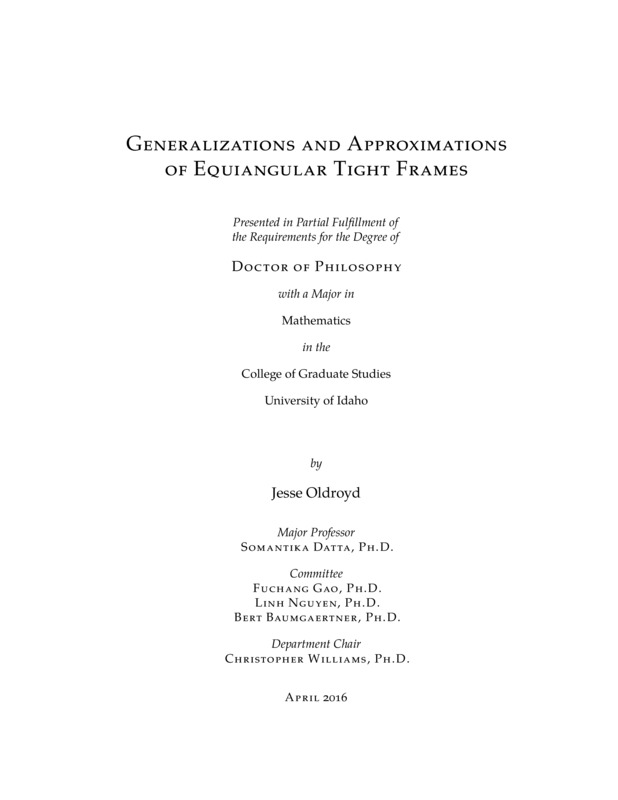Generalizations and Approximations of Equiangular Tight Frames
Oldroyd, Jesse Ernest. (2016). Generalizations and Approximations of Equiangular Tight Frames. Theses and Dissertations Collection, University of Idaho Library Digital Collections. https://www.lib.uidaho.edu/digital/etd/items/oldroyd_idaho_0089e_10817.html
- Title:
- Generalizations and Approximations of Equiangular Tight Frames
- Author:
- Oldroyd, Jesse Ernest
- Date:
- 2016
- Keywords:
- Equiangular tight frames Random approximations Tight frames Welch bound
- Program:
- Mathematics
- Subject Category:
- Mathematics
- Abstract:
-
Frames have become an important tool in signal processing and other applications.
Equiangular tight frames (ETFs) are particularly important examples of frames due to their many desirable properties for signal reconstruction as well as for their deep connections to combinatorics and graph theory.
Unfortunately, ETFs have proven difficult to construct and it is not possible to find ETFs of arbitrary size in a given finite dimensional vector space.
A new characterization of equiangular tight frames of d+1 vectors in a d-dimensional space is presented that gives a faster method of constructing these ETFs.
A separate characterization of ETFs of d+1 vectors in a d-dimensional Hilbert space is given in terms of a maximization problem on a set of d+1 by d+1 matrices, and a related result is also proven for ETFs of 2d vectors in a d-dimensional space.
Different methods for approximating equiangular tight frames are discussed.
The first method looks at frames whose Gram matrices are similar to those of an ETF and this leads to the definition of a k-angle tight frame.
Several constructions of k-angle tight frames are given for real and complex Euclidean spaces and connections are uncovered between k-angle tight frames and combinatorial objects such as regular graphs and association schemes.
The second method uses random matrices to take a given equiangular frame and improve its tightness.
Probabilistic estimates are proved to measure how well the random frame obtained by this method approximates the given equiangular frame.
Finally, we investigate a strategy involving combinatorial designs for adding vectors to an equiangular tight frame of d+1 vectors in R^d to obtain a larger tight frame whose worst-case coherence is nearly optimal.
- Description:
- doctoral, Ph.D., Mathematics -- University of Idaho - College of Graduate Studies, 2016
- Major Professor:
- Datta, Somantika
- Committee:
- Gao, Fuchang; Nguyen, Linh; Baumgaertner, Bert
- Defense Date:
- 2016
- Identifier:
- Oldroyd_idaho_0089E_10817
- Type:
- Text
- Format Original:
- Format:
- application/pdf
- Rights:
- In Copyright - Educational Use Permitted. For more information, please contact University of Idaho Library Special Collections and Archives Department at libspec@uidaho.edu.
- Standardized Rights:
- http://rightsstatements.org/vocab/InC-EDU/1.0/

